Deer love our gardens. They nibble the tops off tomato seedlings. Pepper starts get yanked out and tossed around. Eggplants are gobbled to the ground. Celery? Forget it. Young trees are lucky to survive their first winters. New plantings are more fence than foliage. What's not fenced gets gnawed, girdled, and gone.
Ann Arborites love deer but a vocal minority have been frustrated to the point of allowing a cull. Feelings are mixed. The following collection links to various aspects of the story.
Natural Lands Trust: Deer Management Options (pdf)
Audubon: Managing White-tailed Deer in Forest Habitat From an Ecosystem Perspective, A Pennsylvania Case Study, 2005
A Position Statement of the Michigan Society of American Foresters, 2013
Ann Arbor Deer Management Program webpage
MLive: Another lawsuit over Ann Arbor's deer cull dismissed in Court of Claims, Ryan Stanton, 8-10-2016
"The lawsuit was filed on Feb. 12 by Ann Arbor Residents for Public Safety, a group that claimed the DNR exceeded its authority by permitting the city to hire sharpshooters to kill deer in Ann Arbor parks and nature areas."
MLive: Federal judge dismisses lawsuit over Ann Arbor deer cull, Ryan Stanton, 7-19-2016
"The lawsuit was filed in January by a group called Ann Arbor Residents for Public Safety in objection to a deer cull in January and February that resulted in sharpshooters killing 63 deer in Ann Arbor parks and nature areas."
MLive: 'Deer doctor' to visit Ann Arbor for free seminar on deer-proofing gardens, Ryan Stanton, 5-19-2016
"Sandy Baker, known as the "deer doctor" for her work helping communities with deer-related challenges, will be visiting Ann Arbor's Traverwood Branch Library on Saturday, June 4, from 10:30 to noon, to talk about how to deer-proof gardens."
MLive: Rogue deer infiltrates former robot dinosaur exhibit at Detroit Zoo, Gus Burns, 5-19-2016
"ROYAL OAK -- A wild white-tailed deer made its way through a traffic-heavy section of Royal Oak on Wednesday, getting beyond the walls and ticket booths near Woodward Avenue and 10 Mile Road and eventually to the former Dinosauria exhibit at the Detroit Zoo."
MLive: $145K for deer management included in Ann Arbor's new city budget, Ryan Stanton, 5-17-2016
According to the report, $35,000 is the cost of hiring killers to kill 100 deer.
$110,000 is the cost of
-
-
- studying the killing
- management and administration of the killing
- documenting the killing
- studying alternatives to killing
-
MLive: Ann Arbor residents still divided on shooting deer, survey shows, Ryan Stanton, 5-4-2016
"Results from a recent online survey conducted by the city show a slim majority of respondents — 54.4 percent — support continuing lethal methods to reduce the deer population, while 45.3 percent are opposed.
A larger majority — 61.4 percent — support implementing nonlethal methods such as contraceptives or sterilization to reduce the deer population if Michigan Department of Natural Resources approval can be obtained."
MLive: Ann Arbor seeks feedback on deer cull in new survey, Ryan Stanton, 4-6-2016
MLive: 2 lawsuits seeking to prevent urban deer culls pending in Michigan courts, Ryan Stanton, 4-5-2016
MLive: Council member's emails about deer cull scrutinized by critics, Ryan Stanton, 4-5-2016
MLive: Peaceful memorial rally in Ann Arbor honors lives of 63 deer killed, Ryan Stanton, 4-5-2016
MLive: Deer-involved traffic crashes in Ann Arbor jump 73%, Ryan Stanton, 3-2-2016
MLive: Ann Arbor deer cull ends with 63 deer killed in city parks, Ryan Stanton, 3-1-2016
Between the shooting, the administration, the studies, the helicopter counts, and the "supplies," Ann Arbor spent about $1500 per dead deer
R&D Magazine: Malaria Found in American White-Tailed Deer, Greg Watry, 2-8-2016
"A new study from the Univ. of Vermont published in Science Advances has found that malaria infects up to 25% of white-tailed deer along the United States’ eastern seaboard. Previously, it was thought that malaria was eradicated from the U.S. in the 1950s, according to the Centers for Disease Control and Prevention. Named Plasmodium odocoilei, the malaria parasite represents the first of its kind to live in a deer species."
MLive: Ann Arbor officials ask whether $35K is enough for deer management next year, Ryan Stanton, 2-23-2016
"With a week left to go before the cull ends, the sharpshooters are only about halfway to meeting that goal."
"Between staff costs and [$21,000 for] supplies and materials, Collins said, the city has spent about $48,000 at this point, not yet counting the USDA bill for the cull," [not counting an ecologist hired for $12,500], not counting the USDA gunmen hired for $35,000.
MLive: Survey Counts More Deer In Ann Arbor Than Previous Flyover, 2-23-2016
MLive: Ann Arbor deer count increases from last year, Ryan Stanton, 2-22-2016
MLive: Ann Arbor about halfway to goal of killing 100 deer in parks, Ryan Stanton, 2-16-2016
The following 14 parks remain closed from 4 p.m. to 7 a.m. weekdays for the shooting.
-
- Barton Nature Area
- Bird Hills Nature Area
- Black Pond Woods
- Bluffs Nature Area
- Cedar Bend Nature Area
- Furstenberg Nature Area
- Huron Parkway Nature Area
- Kuebler Langford Nature Area
- Leslie Park Golf Course
- Leslie Woods Nature Area
- Olson Park (dog park still open during regular hours)
- Ruthven Nature Area
- South Pond Nature Area
- Stapp Nature Area
MLive: Ann Arbor deer cull helping Food Gatherers feed the hungry, Ryan Stanton, 2-11-2016
MLive: 16 deer shot in Ann Arbor parks last week, more this week, records show, Ryan Stanton, 1-28-2016
MLive: Ann Arbor facing second lawsuit over deer cull, Ryan Stanton, 1-27-2016
MLive: U-M biologist says Ann Arbor deer cull is 'positive step toward ecological sustainability', Ryan Stanton, 1-14-2016
MLive: 10 city parks no longer closed for Ann Arbor deer cull, Ryan Stanton, 1-13-2016
"City officials announced the decision Wednesday afternoon to keep the following nature areas open to the public during the deer cull."
- Arbor Hills Nature Area
- Braun Nature Area
- Dhu Varren Woods Nature Area
- Foxfire South Nature Area
- Foxfire West Nature Area
- Narrow Gauge Nature Area
- Oakridge Nature Area
- Oakwoods Nature Area
- Onder Nature Area
- Traver Creek Nature Area
MLive: Federal judge denies request to pause Ann Arbor deer cull, Ryan Stanton, 1-11-2016
MLive: Officials not releasing information about deer cull in Ann Arbor, Ryan Stanton, 1-5-2016
MLive: Ten things to know about the Ann Arbor deer cull, Ryan Stanton
MLive: Tensions mount as Ann Arbor deer cull is set to begin, Ryan Stanton, 1-4-2016
MLive: Sharpshooters must get permission to shoot deer near homes, Ryan Stanton, 12-24-2015
MLive: Ann Arbor police to enforce deer cull closures; parks to open on weekends, Ben Freed, 12-18-2015
MLive: Group aims to recall several Ann Arbor council members over deer cull, Ryan Stanton, December 4, 2015
MLive: Ann Arbor council member facing recall threat for vote on deer cull, Ryan Stanton, December 2, 2015
MLive: Should Ann Arbor allow electric fences to keep deer out of gardens?, Ryan Stanton, November 20, 2015
City Council Member Chuck Warpehoski, D-5th Ward, said this week he's considering bringing forward ordinance changes to ease fence restrictions in the city, possibly allowing electric fencing around gardens, as well as the use of high-tension wire to increase the height of backyard fences to 10 feet.
MLive: Ann Arbor council votes 10-1 to hire sharpshooters to kill deer in city parks, Ryan Stanton, November 6, 2015
In addition to temporarily lifting ordinance restrictions on firing guns in parks, the council approved an agreement with the U.S. Department of Agriculture Animal and Plant Health Inspection Service, also known as USDA-APHIS, to carry out the cull this winter at a cost of up to $35,000.
MLive: Ann Arbor council to vote on hiring sharpshooters to kill 100 deer, Ryan Stanton, November 5, 2015
MLive: Ann Arborites for and against deer cull will get chance to speak out Nov. 5, Ryan Stanton, October 20, 2015
MLive: Ann Arbor council asked to allow guns in parks for deer cull, Ryan Stanton, October 19, 2015
MLive: Humane Society defends its advocacy against Ann Arbor deer cull, Ryan Stanton, October 16, 2015
MLive: Petersen clarifies position on Ann Arbor deer cull at latest City Council candidate forum, Ryan Stanton, October 12, 2015
MLive: Humane Society's campaign against deer cull brings contract funding into question, Ryan Stanton, October 11, 2015
Council Member Kirk Westphal, D-2nd Ward:
"What's frustrating is that they are disseminating false information locally, which is confusing citizens and costing council and staff a significant amount of time, which could be more productively used. There was an ad that ran locally claiming a deer cull endangers children by rifle shots that miss... I can tell you that deer-vehicle collisions do, in fact, kill and maim people every year."
MLive:
"Police reports show there haven't been any fatal deer-involved crashes in Ann Arbor in at least the past decade. Of the 51 deer-involved crashes reported in Ann Arbor last year, the only injury reported was when a 30-year-old Brighton man swerved to avoid a deer on Newport Road and hit a tree, ending up with a small cut on his elbow. He refused medical treatment.
According to public health officials, there haven't been any cases of locally contracted Lyme disease."
MLive: Ann Arbor deer cull controversy becomes election issue in 2nd Ward, Ryan Stanton, October 1, 2015
August 17, 2015, City Council approved the establishment of a deer cull program for the next four years on City of Ann Arbor property beginning in the winter of 2016. In addition, City Council directed city staff to continue to explore an experimental deer fertility control program with the Humane Society of the United States. The deer management program aims to decrease the deer population in order to reduce deer-human negative interactions. City staff will begin work on a culling proposal that will require Michigan Department of Natural Resources approval. Many more details need to be worked out. Communication with residents will continue throughout the cull development process.
In addition, City Council approved at first reading an ordinance that bans the feeding of deer in Ann Arbor, making it a civil infraction. The ordinance will come back to City Council for a second reading on September 8 before it goes into effect.
- Washtenaw Citizens for Ecological Balance (wc4eb.org is a pro-cull advocacy group)
MLive: Ann Arbor marijuana advocate worried people smoking pot in parks could be shot during deer cull, Ryan Stanton, 10-6-2015
MLive: Ann Arbor deer cull controversy becomes election issue in 2nd Ward, Ryan Stanton, October 1, 2015
With Ann Arbor officials making plans to hire sharpshooters to kill 100 deer this winter, "stop the shoot" has become the official battle cry of animal rights activists.
Save the Deer - an anti-cull website
"City Council voted to spend $90,000 of taxpayer money to use sharpshooters within City limits."
The Deer Management Project, City of Ann Arbor, August, 2015
MLive: How will Ann Arbor carry out deer culling? City officials explain process, Ryan Stanton, August 25, 2015
MLive: What would a deer feeding ban mean for Ann Arbor?, Ryan Stanton, August 24, 2015
MLive: Ann Arbor council votes 8-1 to approve controversial deer cull, Ryan Stanton, August 18, 2015
Ruminations on Deer, Damn Arbor (blog) August 17, 2015
Our Deer are Mostly Ann Arborites - The Ann Arbor Observer, February, 2015
MLive/Ann Arbor News - the complete list of articles.
Oh Deer - Damn Arbor (a local blog)
A series of articles in another local blog:
- Oh, Deer! Ann Arbor’s Herd Problem, Local in Ann Arbor (blog), December 3, 2014
- Oh, Deer – Will Ann Arbor Find A Solution?, Local in Ann Arbor (blog), December 15, 2014
- Oh, Deer – Managing the Public, Local in Ann Arbor (blog), December 17, 2014
- Oh, Deer – The Survey, Local in Ann Arbor (blog), January 31, 2015
- Deer and the Community Conversation, Local in Ann Arbor (blog), February 16, 2015
- Deer and the Numbers Explosion, Local in Ann Arbor (blog), February 24, 2015
- Deer and the Vacuum Effect Fable, Local in Ann Arbor (blog), March 8, 2015
- Deer and the Web of Life, Local in Ann Arbor (blog), March 26, 2015
- Deer and the Flowers of the Earth, Local in Ann Arbor (blog), May 31, 2015
- Deer and the Population Problem, Local in Ann Arbor (blog), August 4, 2015
MLive: See and share photos of deer in neighborhoods throughout Ann Arbor, Ryan Stanton, February 20, 2015
Ann Arbor Deer Management Program Documents:
City Council Deer Management Report
Council Resolution for Deer Management Plan and Funding
RFP for Consultation Services for Development of Deer Management Plan
Press release: City Seeks Input for Deer Management Plan
First Public Meeting Presentation- Dec. 10, 2014
First Public Meeting Agenda - Dec. 10, 2014
Press release: Second Deer Management Public Meeting Scheduled
Second Public Meeting Presentation - Feb. 5, 2015
Second Public Meeting Agenda - Feb. 5, 2015
February 10, 2015 Aerial Deer Survey Results Map
March 6, 2015 Aerial Deer Survey Results Map
Press Release: City of Ann Arbor Releases Aerial Deer Survey Results
Press Release: City of Ann Arbor Schedules Third Deer Management Public Meeting
Third Public Meeting Agenda - April 16, 2015
Third Public Meeting Presentation - April 16, 2015
Recommendations for Deer Management in Ann Arbor Report - May 2015
July 13, 2015 Deer Work Session Staff Presentation
July 13, 2015 Humane Society of the United States Deer Work Session Presentation
Resolution to Establish a Deer Management Program within the City of Ann Arbor - August 17, 2015
- from a report by Kathleen Lavey, Lansing State Journal, November 30, 2015
For many urban and suburban folks, “off the grid” signifies survivalist, and “straw bale” seems like a code for shoddy construction. That’s not the case with the home built by Joe and Shelly Trumpey and their family, Grass Lake residents who were among families named Homesteaders of the Year for 2015 by the magazine Mother Earth News.
Their 2,200-square-foot, two-story home has a dramatic timber-frame entrance with huge windows, rust-colored stucco walls, a green metal roof and a cupola. It has an herb garden in front and every modern convenience inside. Outside the house you'll find heirloom animals like American mule-footed pigs, long haired highland cattle, four-horned Jacob sheep, chickens, and turkeys. They sell the wool and eat the rest.
Trumpey is always looking at new possibilities for sustainability, but admits his family may have reached a peak. Other than adding a dairy cow, we’re pretty maxed out at this point,” he said.
This link takes you to the story and photographs of their off grid home, a far cry from yesteryear's Yurts.
Southeast Michigan apple maturity report – September 30, 2015
by Bob Tritten, Michigan State University
This is a delicious bit of applied science:
With good weather over the last two weeks, most growers report they are at the midpoint of apple harvest. Growers have finished up Jonathan and Cortland harvest and have moved on to Jonagold, Empire and early maturing Golden Delicious blocks. Northern Spy and some early maturing Red Delicious blocks are mature at some farms as well.
This week, 10 apple varieties were sampled and tested for maturity. Fuji, CandyCrisp, Cameo and Crispen were added to the sampling this week to get an early read on their maturity. I did not sample Cortland or Jonathan this week as both are mature. Harvest dates for most varieties are running a few days ahead of the predicted harvest dates.
Fruit firmness or pressure has maintained about the same over the past week, and brix has improved in most varieties. Fruit size remains good this season, with the possible exception of some Red Delicious blocks that were not thinned well. Bitter pit is a problem in many Jonagold blocks and blister spot is being found in many Crispen blocks. Woolly apple aphid populations are very high in many apple blocks.
I continue to get reports about how easily fruit is bruising this season. It is mostly showing up a few days after harvest when fruit has been in storage. This bruising is most likely the result of the abundant rains that most growers have had over the past few months.
The East Michigan Apple Harvest Report is produced by Bob Tritten, district fruit educator, Flint, MI, email This email address is being protected from spambots. You need JavaScript enabled to view it.">This email address is being protected from spambots. You need JavaScript enabled to view it., office phone 810-244-8555, cell 810-516-3800 and fax 810-341-1729. Special thanks to four orchards that allow me to harvest fruit for analysis from their farm every Monday during the apple harvest season, these farms include: Spicer Orchards in Hartland, Erwin Orchards in South Lyon, Westview Orchards in Romeo and Hy’s Cider Mill in Romeo. Thanks to so many other orchardists that I collect fruit samples from their farms to include their varieties on more of a random basis. Lastly, thanks to the Post-Harvest Lab in the Department of Horticulture at Michigan State University that provides the quick and very accurate analysis of so many apple samples in the fall. Dr. Randy Beaudry and his students do a fantastic job and are a valuable part of our Apple Maturity Team.
- Update: We have added links to an article about the Monarch life-cycle and a 3D Monarch movie
- Update: We have added links to a Diane Rehm story that aired June 3, 2015
- Update: We have added links to a PRI story that aired May 21.
"A new federal plan aims to reverse America's declining honeybee and monarch butterfly populations by making millions of acres of federal land more bee-friendly, spending millions of dollars more on research and considering the use of fewer pesticides.
While putting different type of landscapes along highways, federal housing projects and elsewhere may not sound like much in terms of action, several bee scientists told The Associated Press that this a huge move. They say it may help pollinators that are starving because so much of the American landscape has been converted to lawns that don't provide foraging areas for bees."
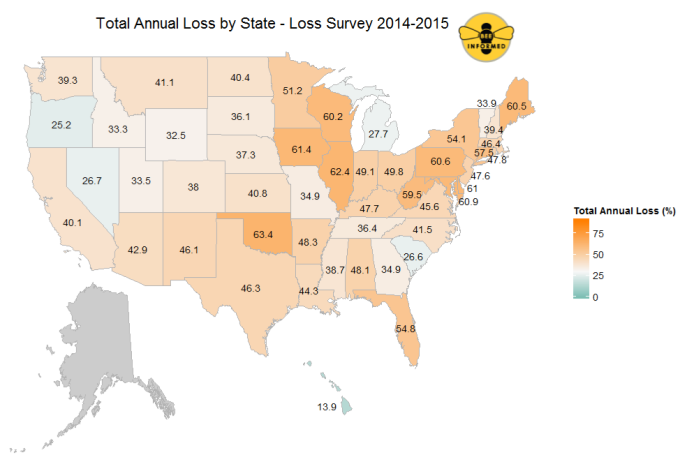
"Pollinators are struggling," White House Science Advisor John Holdren said in a White House blog post. "A new federal survey found that beekeepers lost more than 42 percent of their colonies last year. More of the insects died in summer than winter for the first time since the US Department of Agriculture launched its annual honeybee survey. The number of monarch butterflies that spend the winter in Mexico's forests is down by 90 percent or more over the past two decades. The goals of the new strategy are to reduce overwinter honeybee death to 15% and to increase the Monarch population to 225 million."

"The stated goal of the bee and butterfly conservation plan is to restore and protect nearly seven million acres of habitat for these pollinating insects using a north-to-south corridor across the country. That will replace the land that's been lost to butterflies and pollinators due to pesticide use. Patches of high-quality habitat that's rich in flowers and free of pesticides forming a corridor from Mexico to Canada will help monarchs to find nectaring and breeding areas as they travel," says Scott Hoffman Black, the executive director at the Xerces Society for Invertebrate Conservation."
The Diane Rehm Show, June 3, 2015
Environmental Outlook: New Efforts to Support the Ailing Bee Population
Most scientists agree the problem is a combination of pests, disease, poor nutrition and toxins from pesticides, yet how big a role each of those plays is up for debate – as are the solutions. Now, President Barack Obama has weighed in with a plan to save the bees and other pollinators. But some say it doesn’t go far enough. We learn more about new efforts to support the ailing bee population.
You can help. Milkweed plants like these are where Monarchs spend summer, turning from caterpillars into butterflies.
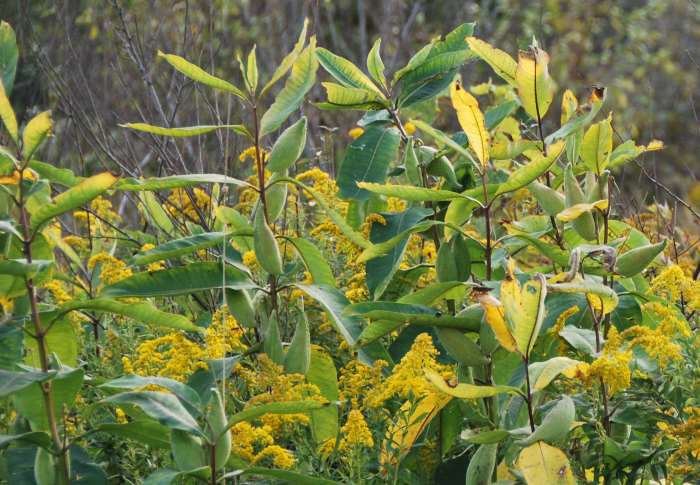
To suburbanites, they're weeds. To the Monarch butterfly, they are hearth, home, and nursery. Mow around them. Plant a $3 butterfly garden. But be careful. Potted milkweed plants (Asclepias) from Nurseries and Home Centers have probably been treated with systemic insecticides. Treated plants can kill Monarch caterpillars in three bites.
Below are photos of my neighbor's honeybees visiting spring tree blossoms on my place. The blossoms are pretty, but they don't last long. Because I don't use herbicides that kill everything but lawn grass, during the rest of the year my neighbor's bees can feed on clover in my lawn. Clover flowers continuously through the summer. The local bees can also feast on spring Dandelions. I don't kill those either.
Bordering my minimal mowed area is a field filled with wildflowers like the Goldenrod above, its kindred Asteraceae, and of course, Milkweed. Pollinators need all these to feed on while your fruit trees grow fruit and your garden makes vegetables.
What else do these "weeds" do? They provide oxygen for people who live surrounded by asphalt.
The Life cycle of the Monarch. The migration north takes 3 generations, following the Milkweed bloom. A final fall generation migrates south, overwinters, mates, and lays the eggs of the generation which will begin the return journey north.
Flight of the Butterflies - a 3D movie
After years of research, in 1975 Dr. Fred Urquhart discovered the southern terminus of Monarch migration. This movie tells the story. It turns on the discovery of PS 397, the monarch butterfly tag that was released by two school boys and their teacher from Chaska Minnesota in early August 1975. This same tag and butterfly ended up being the very one Dr. Fred Urquhart found four months later, on January 9th, 1976, 10,000 feet high in the remote Sierra Madre mountains of Michoacan Mexico. The butterfly would have flown over 2,000 miles and for at least two months to get there.
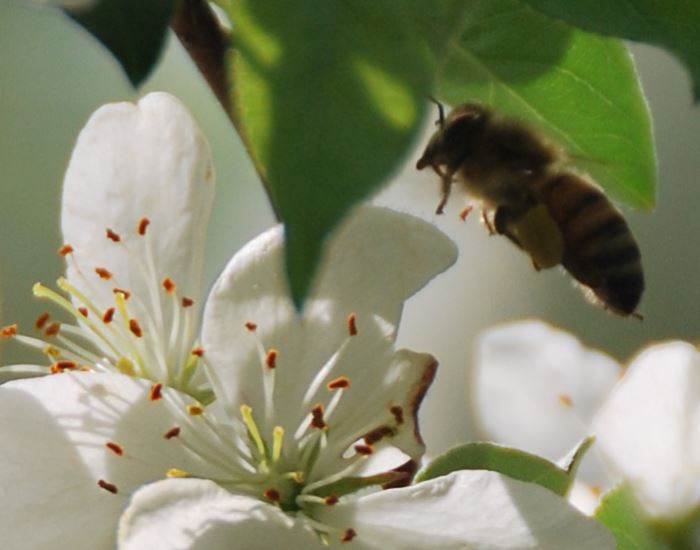
Honeybee hovering over a Wild Apple blossom
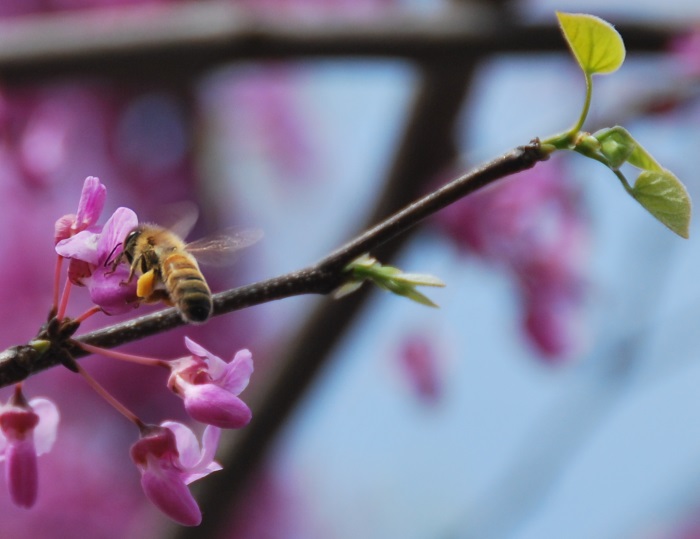
Honeybee feeding on a Redbud blossom
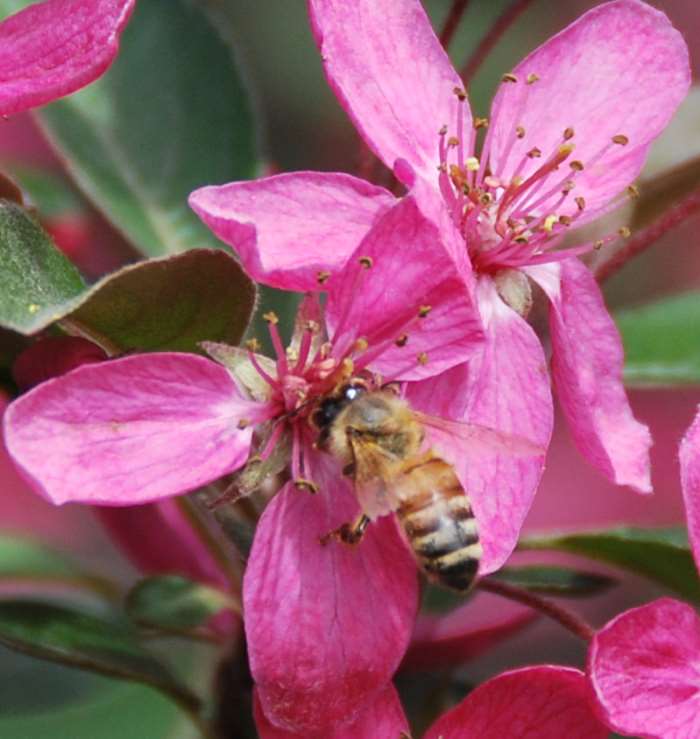
A Cranberry-hued Crabapple blossom with honeybee
Read more: You Can Help the Honeybees, the Monarchs, and other Northfield Township Pollinators
Northfield Township Beekeeper C. Infante's Action Statement: You Can Help the Honeybees.
Southeast Michigan Beekeepers Association (SEMBA)
Michigan Bee Association (MBA)
The University of Minnesota Bee Lab
Bee Informed Partnership: Using Beekeepers' real world experience to solve Beekeepers' real world problems
Nicotine Bees: a documentary that a friend of mine played a part in. Part of it is here on Youtube. The entire film was on Youtube last year but got yanked. If it reappears I'll post a link. Meanwhile, you can buy a copy.
Articles and Publications:
Entomology Today: Varrao Mites Use Chemical Camouflage to Mimic Honey Bee Scent, June 4, 2015
Biology Letters: Varroa destructor changes its cuticular hydrocarbons to mimic new hosts, June 3, 2015
WhiteHouse.Gov: Announcing New Steps to Promote Pollinator Health, May 19, 2015
CNN: After the Sting of Vanishing Bees, White House Pollinates Protection Plan, May 19, 2015
The Hoops News: 40% increase in Honeybee deaths reveals unknown flaw in our agro-ecosystems, May 15, 2015
The Telegraph, Honeybee crisis deepens as die-offs surge in 'paradise' of summer, May 14, 2015
Bee Informed: Colony Loss 2014-2015, Preliminary Results, May 13, 2015
National Geographic: Honeybee Dances Map Healthy Landscape, May, 2015
Ron Meador: Nicotine-like insecticides may be luring bees to their poisoning, April 30, 2015
Mother Jones: Bees Love Nicotine, Even Though It's Killing Them, April 29, 2015
NBC: Lowes to stop selling Neonic pesticides linked to Bee Death, April 9, 2015
MinnPost: In no particular hurry, EPA limits use of bee-killing crop treatments, April 7, 2015
NBC: Portland Bans Insecticide to Protect Declining Honey Bees, April 2, 2015
NBC: EPA Restricts Use of Pesticides Suspected of Killing Bees, April 2, 2015
MinnPost: Full House Turns out for Expert's Insights, March 11, 2015
Marla Spivak: To grasp our bee's plight and prospects, stay focused on food, March 11, 2015
Entomology Today: Honey Bee Pathogens are a Threat Year Round, February 10, 2015
Entomology Today: How do Varrao Mites know when it's time to leave Honey Bee hives?, August 29, 2014
National Geographic: As Honeybees Die Off, First Inventory of Wild Bees Is Under Way, July, 2014
Entomology Today: U.S. Beekeepers lost 23% of colonies last winter, May 15, 2014
Entomology Today: Add Tobacco Ringspot Virus to Possible Causes of Colony Collapse Disorder, January 21, 2014
National Geographic: The Plight of the Honeybee, May 10, 2015
MinnPost: Honeybee collapse worsens; one Minnesotan's losses run to 65%, April 3, 2013
MinnPost: Long term fate of honeybees shows new losses, little gain in new survey, April 3, 2013
SafeLawns.Org: Beekeepers Sue EPA for Bee-Killing Pesticides, March 25, 2013
SafeLawns.org: Par for the Course: As Bees Die, Governments Sit Idly By, June 6, 2012
TreeHugger: "Nicotine Bees" Population Restored with Neonicotinoids ban, May 15, 2010
TreeHugger: More "Save the Bees" Success: What Can Other Environmental Campaigners Learn?, June 28, 2009
TreeHugger: Bees Rejoice: One Potential Cause of Colony Collapse Disorder Identified, April 17, 2009
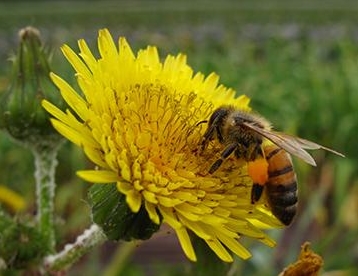

From: Bird, Wilma - NRCS - Ann Arbor, MI, MI <This email address is being protected from spambots. You need JavaScript enabled to view it.>
To: Writing4All <This email address is being protected from spambots. You need JavaScript enabled to view it." target="_blank" data-cke-saved-' + path + '\'' + prefix + ':' + addy95063 + '\'>'+addy_text95063+'<\/a>'; //--> >
Sent: Thu, Jun 4, 2015 5:24 pm
Subject: Pollinator Habitat -Conservation Planning

"Pollinators are struggling," White House Science Advisor John Holdren said in a White House blog post. "A new federal survey found that beekeepers lost more than 42 percent of their colonies last year. More of the insects died in summer than winter for the first time since the US Department of Agriculture launched its annual honeybee survey. The number of monarch butterflies that spend the winter in Mexico's forests is down by 90 percent or more over the past two decades. The goals of the new strategy are to reduce overwinter honeybee death to 15% and to increase the Monarch population to 225 million."
Read more: June 24 Update: The NRCS Pollinator Health Workshop
This spring I rototilled five trailer's worth of Tuthill Farms compost into my garden plot. It is great stuff, well aged and cool to the touch. After the mixing our heavy clay loam is much easier on us and the plants.
Their farm and compost manufactory is located east of US-23, on Tuthill Road, half a mile north of Nine Mile Road, one mile west of Marshall Road (called Spencer Road here in Northfield Township). You're reading this because the Tuthills and their farm are featured in an August 12 Livingston Daily story. Here are a few lines for context:
Jim Tuthill and his wife, Sandra Tuthill, are the fifth generation to work the land. Their kids James, Emily and Ashley grew up there. Daughter Emily and her husband, Stanley Stinson, currently live there with their three young children — the seventh generation on the farm. The family has owned it for more than 150 years. The Tuthill family has had to adapt and make big changes over the years, reacting to rapid growth in the area.
“We were able to diversify instead of being forced out. So, all that growth is really an opportunity,” Sandra Tuthill said.
A week or so ago a Paramount Pictures location scout asked to photograph our old barn. The director of an upcoming film, Looking for Alaska, needs an old barn or barns. Would my barn work? Only if I can fend off the vultures. I forwarded the info to a friend whose barn has a much more nestled into its surrounds-feel, with lots of cows and chickens and goats. If you have a barn and want to give location scout Kayla Porvaznick a look at it, the contact info (and the pdf (only 32KB) is below.
The production is expected to hire about 1,700 extras.. They're also hiring about 200 qualified crew members. The Free Press article has an address where you can send your resume.
Read more: Paramount Pictures Scouts Looking at Northfield Barns
Page 1 of 2

